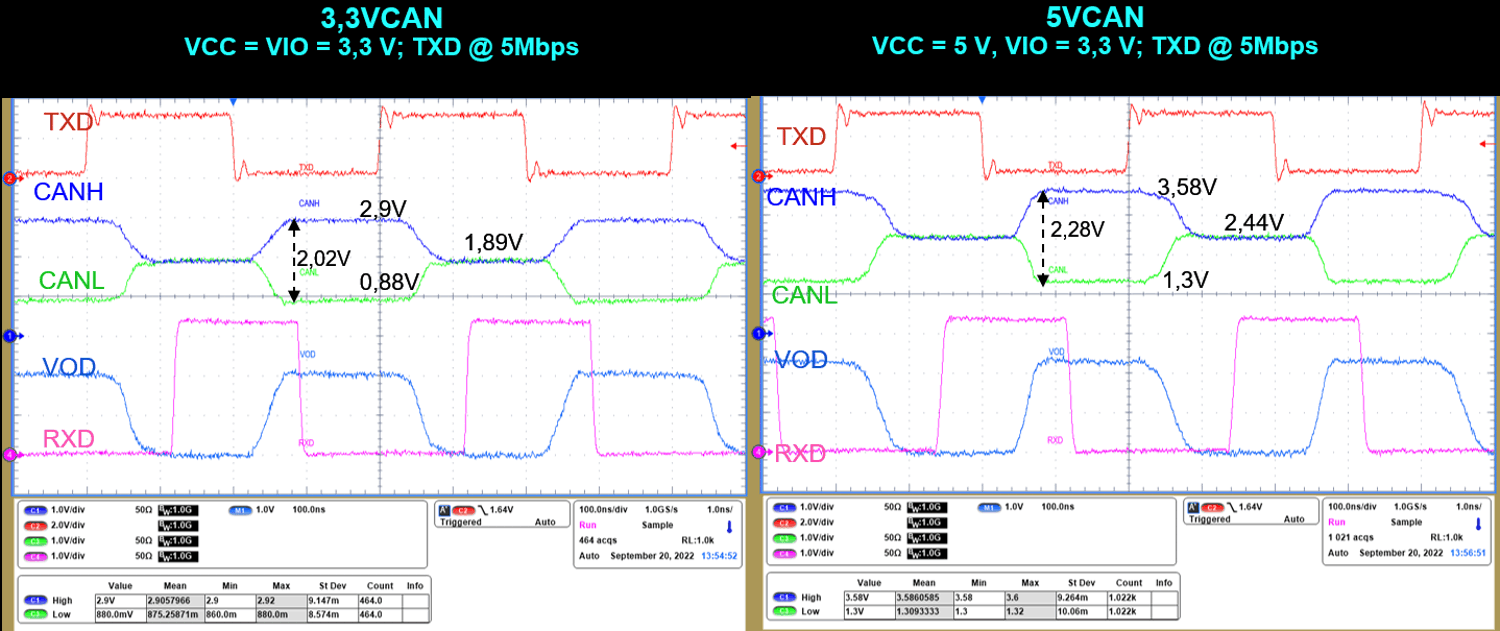SLLA636A June 2024 – August 2024 TCAN3403-Q1 , TCAN3404-Q1
3 TI's TCAN3403-Q1, TCAN3404-Q1 CAN FD Transceivers
TI has released two automotive-qualified and EMC-certified 3.3V CAN FD transceivers. Table 3-1 shows the differences between the TCAN3403-Q1 and TCAN3404-Q1.
| Part Number | Pin 5 | Pin 8 |
|---|---|---|
| TCAN3403-Q1 | Ultra-low power shutdown mode | Low power standby mode with remote wakeup |
| TCAN3404-Q1 | Low voltage I/O support |
A few more things to note:
- Even with 3V minimum supply (since 3.3V main supply can vary by ±10%), the devices are designed for a minimum 1.5V of differential output voltage with a 50Ω bus load. This maintains compliance to the VOD specification in ISO 11898-2(2024).
- Receiver thresholds are exactly same as standard 5V CAN transceivers and maintains compliance to ISO11898-2 (2024).
- Single-ended specifications are listed in Table 3-2, which is a slight deviation from CAN physical layer standard ISO 11898-2(2024).
| Parameter | Conditions | Min (V) | Max (V) |
|---|---|---|---|
| VCANH | Dominant output, Bus load 50 Ω ≤ RL ≤ 65 Ω | 2.25 | VCC |
| VCANL | 0.5 | 1.25 | |
| VCANH, VCANL | Recessive | 1.9 V (typical) | |
Driver transistors (highlighted in dotted red rectangle in Figure 2-1) have to be sized so that the drop across the high and low sides is a combined 1.5V maximum at a 3V operating bus supply. This reduction in the minimum operating supply mandates device recessive biasing to be positioned at 1.9V, as opposed to 2.5V for standard 5V CAN transceivers. Because CAN is a differential interface, single-ended voltages in the dominant and recessive states are not crucial for proper operation or communication. This means that the devices are compatible with ISO 11898-2 (2024).
Figure 3-1 is an application diagram with TCAN3404-Q1 demonstrating single 3.3V supply regulator to run the MCU and the CAN transceiver, thereby eliminating the 5V regulator that standard 5V CAN transceivers need.
 Figure 3-1 Application Schematic of a
3.3V CAN Transceiver
Figure 3-1 Application Schematic of a
3.3V CAN TransceiverFigure 3-2 compares single device level waveforms between TCAN340x-Q1 and standard 5V CAN.
 Figure 3-2 Waveform Comparison of a 5V
CAN and 3.3V CAN Transceiver
Figure 3-2 Waveform Comparison of a 5V
CAN and 3.3V CAN TransceiverWhen combining the TCAN3403-Q1 and TCAN3404-Q1 with 5V CAN transceivers on the same bus network, a slight recessive bias mismatch can have an impact on emissions. But proprietary design techniques implemented in both devices maintain EMC compliance per IEC 62228-3 in both homogeneous (both nodes in network, as in the TCAN340x-Q1) and heterogeneous (one node is the TCAN340x-Q1, the other node is standard 5V CAN) network conditions.
Other features of the TCAN3403-Q1 and TCAN3404-Q1 are:
- A high bus-fault tolerance up to ±58V that maintains no device damage in the event of miswiring faults for 12V and 24V battery applications.
- An extended common-mode operating voltage range of ±30V ensures the receiver continues to receive data without disruption, even in the presence of a large ground potential difference or voltage interference.
- Footprint compatibility to standard 5V CAN transceivers, while also having a shutdown feature that reduces supply current consumption to <5µA, enabling seamless upgradability.
- Package options offered in leaded small-outline integrated circuit (SOIC)-8, leadless very small-outline no-lead (VSON)-8 with wettable flanks, and ultrasmall leaded small-outline transistor (SOT)-23.
Many 3.3V CAN transceivers were already available in the market, but none met both auto-qualification and EMC certification requirements. The TCAN340x-Q1 is an option for automotive designers looking for a fully interoperable 3.3V CAN transceiver that overcomes EMC challenges in heterogeneous networks.